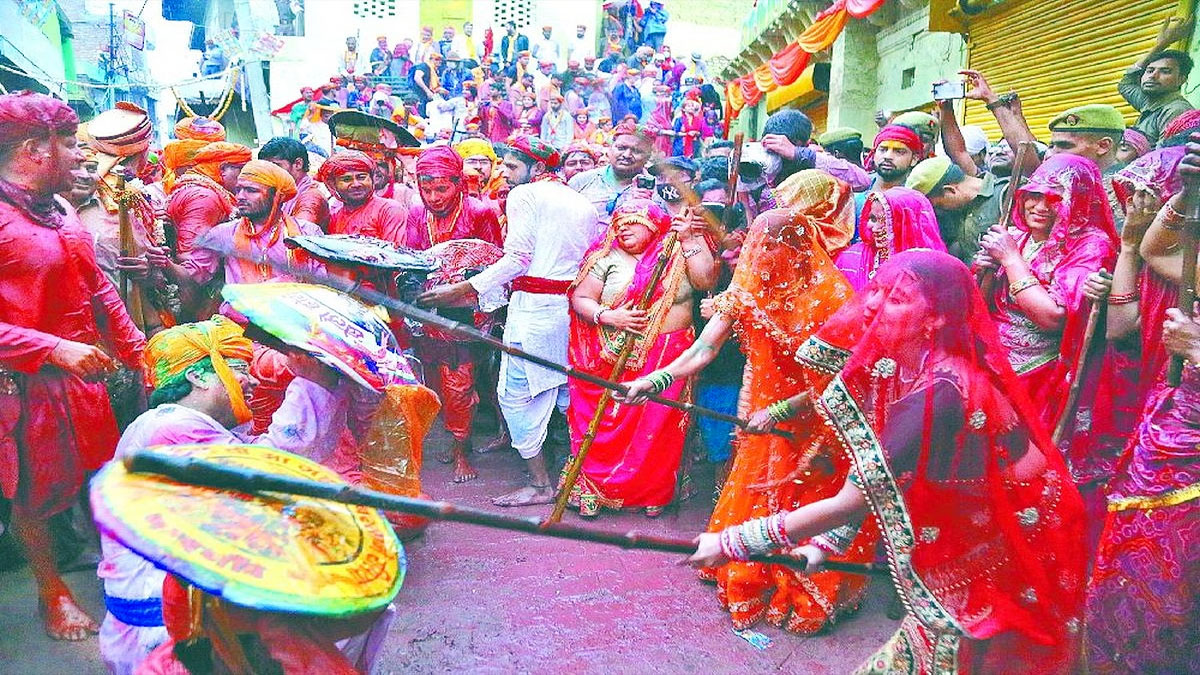Agra: Laddumar Holi was played with great enthusiasm at Shri Ladliji Temple in Barsana. Lakhs of devotees from across the country and abroad enjoyed Holi wonderfully. People of Nandgaon and Barsana Goswami community performed community singing in the Barsana temple complex. After accepting the invitation for Lathamar Holi, laddus were showered in the temple premises. Lathmar Holi will be played in the colorful streets of Barsana on Monday.
Devotees gathered in Shri Ladli Ji Temple…Barsana
The joy of Holi will remain till April 2: 17th March Laddu Holi Barsana, 18th March Lathmar Holi Barsana, 19th March Lathmar Holi Nandgaon and Rawal, 20th March Birthplace, Tha. Banke Bihari, 21 March Chhadimar Holi in Gaekul, 24 March Phalain, 25 March Dhulheri, 26 March Baldev, village Jab, Mukhrai, 27 March Bathain, Gidoh, 31 March Mahavan, 2 April Rangji Temple.
Dwarkadhish Temple…Lord’s Holi with devotees on the symbolic banks of Yamuna
On Sunday, in the temple of Pushtimargiya sect, Dwarkadhish, Rajadhiraj along with Patrani, sitting on the symbolic bank of Yamuna, poured colors on the devotees with a silver pitcher. Women, men and children were seen covered in colors and gulal being blown by the priest in the temple. This sequence will continue every morning till 25th March in the darshan of Rajbhog from 10 am to 11 am. On March 20, Thakurji will play Holi sitting in Kunj.
Radhavallabh Temple…Radha Krishna will leave on 20th to fulfill 400 years old tradition
The almost 400 year old Holi tradition of Thakur Radhavallabh Temple will be continued on Rangbharani Ekadashi on March 20. From the big Rasmandal, Priya-Priyatam will reach Athakhambha with the marks in the form of Radhakrishna. From here, sitting in the carriage, the form of Radha Krishna will tour the city with his friends and invite the people of Braj for Holi. After this ride, Holi of colors will begin in the temples of Vrindavan.
Stampede during Laddumar Holi, 17 devotees injured
During Laddu Maar Holi at Ladli Ji Temple in Barsana on Sunday, the railing on the stairs of the temple broke due to the pressure of the crowd. This caused a stampede and 17 devotees were crushed and injured. The injured were admitted to the Community Health Center and District Hospital. Most of the devotees suffered injuries to their hands, legs and back. Devotees from all over the country and the world had reached Barsana to enjoy Laddu Holi. According to the administration, about 10 lakh devotees had reached Barsana. More than 20 quintals of laddus were thrown at the devotees.
The Hurriyas of Nandgaon have been the brothers-in-law of Barsana for 5,000 years.
Barsana’s friends went to Nandgaon on Sunday to invite them for Hori. He respected the Huriyars of Nandgaon like his brother-in-law. But you will be surprised to know that this tradition has been followed for five thousand years without marriage. The people of Barsana-Nandgaon do not marry their sons and daughters among themselves. This unique custom of Braj has been followed by people of all castes and religions for five thousand years.
Mahendra Pratap Singh, a PhD scholar doing research on Shri Krishna and Braj, says that Surdas’s lines… “Udhau man na bhaye ten-twenty, ek huto so gayau syam sang, kau aradhe ees”
This is enough to show the love of Braj residents, especially the Gopis, for Kanha. It has been more than five thousand years since the conversation between the Gopis who sacrificed everything for Krishna and Uddhav. But even today marriages of Barsana girls do not take place in Nandgaon. In the world famous Nandababa temple of Nandgaon, Radharani is seen as the daughter-in-law of the house. Unlike Nandababa, Mata Yashoda, Balbhadra and Revati ji, Radharani follows the tradition of daughter-in-law in a corner.
Holi is world famous…but relationship is not acceptable
It is another matter that Holi of Barsana and Nandgaon is world famous, but even today relations of the material world are not allowed in these two villages. This unique relationship has continued for the last five thousand years. While playing Holi, there is a lot of laughter and banter between the Huriyares and Huriyarins of both the villages, but they do not accept getting tied up in worldly relationships through marriage.
Agra: Holi started in Braj from Sunday, Lathmar Holi in Barsana today
